10 Essential Hand Reflexology Points

Written by
Gina Mason
Reviewed by
Prof. Benjamin Murphy, Ph.D.Maps of hand reflexology points to body systems for natural stress relief.
Ten of the key points include Heart 7 for anxiety and LI4 for headaches.
Apply pressure firmly enough to feel dull ache, but not pain.
If pregnant, skip LI4 and use PC6 for nausea relief.
Use 5 minutes a day consistently to maximize cumulative benefits to well-being.
Reflexology can be used in conjunction with care already received from a medical health professional; but it is not used to "cure" any present diagnosed condition.
Article Navigation
There are points of hand reflexology associated with the various systems of your body that go back thousands of years to ancient Chinese traditions, over 5000 years old. The hands are a microcosm representing the organs and parts of the body. I have seen how helpful this mapping system is in understanding the body's signals. This practice is suitable for anyone seeking natural healing or wellness methods.
This gentle process can be easily incorporated into your everyday self-care routine. No special instruments are required. You can apply gentle pressure to these points to give you support for your sense of well-being. It is essential to remember that this is complementary to medical treatment, rather than contraindicating or replacing it. I always advise my clients to continue with their professional consultations while trying out reflexology.
Safety is paramount when exploring the body's energy meridians. Begin with light pressure and notice the sensations provided. I recall helping beginning students avoid classic errors, such as pushing too hard. This method teaches you to take conscious authority over your health journey.
10 Essential Hand Reflexology Points
Concentrate first on anxiety-relieving points like Heart 7 (Shenmen), located in the wrist crease between the ring and pinky fingers, and apply gentle pressure here before going to sleep. I have taught clients how to use this region daily for calming effects. Another anxiety point exists on the wrist near the base of the pinky finger.
To control pain, press firmly on Hand Valley (LI4) located in the fleshy area between the thumb and index finger. This is effective for headaches. The Inner Gate (PC6) is located three finger-widths above the inner wrist. Press on this point before meals to relieve digestive discomfort. These points will provide prompt relief.
Systemic benefits exist, such as along the Lung Meridian, particularly along the thumb. Trace during changes of season. The Four Seams at the joints of the fingers assist with digestion especially in children. I recommend gentle rotations here before meals. Base of Thumb below your thumb helps the lungs.
Don't neglect using Fingertips for sinus congestion and Outer Gate (SJ5) back of hand for energy. Use these during fatigue. Don't forget Small Intestine 3 ( SI3)below your pinky for stiffness in the neck. These ten points provide a comprehensive toolkit for self-care.
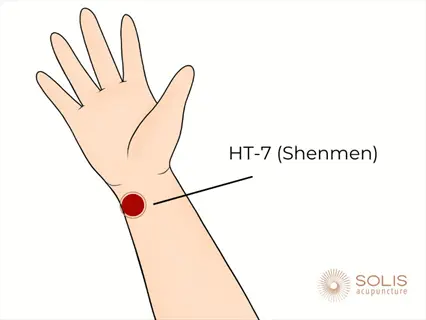
Heart 7 (Shenmen)
- Located in the wrist crease aligned between ring and pinkie fingers near a prominent bone
- Applying gentle circular pressure here may help calm anxiety and reduce nighttime restlessness
- Traditional practice suggests 30-second holds repeated three times during stressful situations
- Often targeted for emotional balance and regulating heart rhythm sensations
- Most effective when pressure is firm enough to feel slight tenderness without pain
- Commonly paired with deep breathing exercises for enhanced relaxation effects
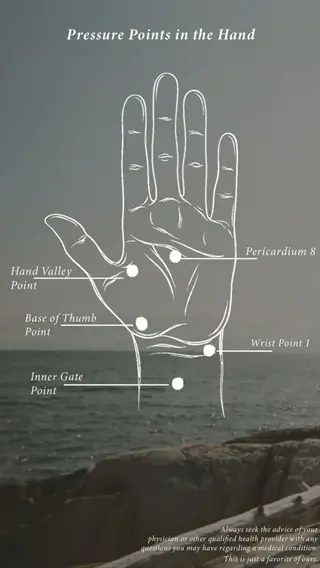
Hand Valley (LI4)
- Found in the fleshy webbing between thumb and index finger on both hands
- Firm pressure here may help alleviate tension headaches and migraine discomfort
- Apply steady thumb pressure for 10 seconds while taking slow, deep breaths
- Traditional warning: Avoid during pregnancy due to potential uterine stimulation
- Often called the 'great eliminator' for its use in detoxification practices
- Can be stimulated using acupressure rings or simple self-massage techniques

Inner Gate (PC6)
- Positioned three finger-widths above wrist crease between two tendons
- Applying pressure may reduce nausea from motion sickness or morning sickness
- Use thumb to massage in small circles before travel or meals
- Clinical studies show effectiveness for chemotherapy-induced nausea management
- Pressure should create a dull ache sensation without sharp pain
- Often targeted with sea-bands for continuous gentle stimulation
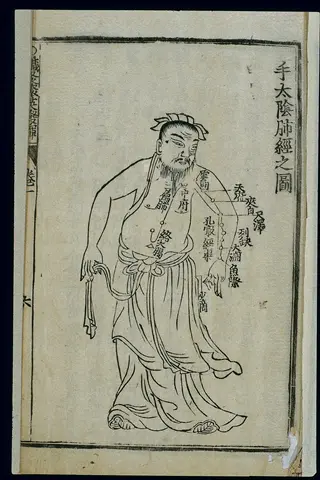
Lung Meridian (LU Series)
- Runs along thumb edge from tip to wrist with multiple pressure points
- Stimulating this pathway may support respiratory health during seasonal changes
- Use thumb to trace and massage entire length during congestion episodes
- Particularly tender points may indicate respiratory system imbalances
- Traditionally associated with grief processing and emotional release
- Combine with steam inhalation for enhanced respiratory support
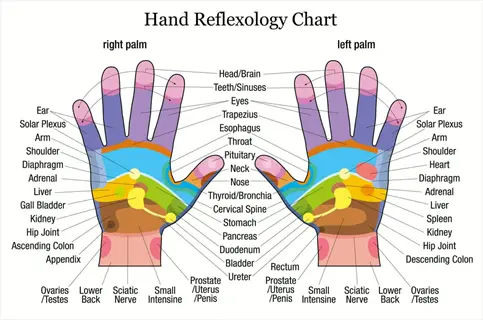
Small Intestine 3 (SI3)
- Located below pinkie finger in the depression near hand's outer edge
- Firm pressure may relieve neck stiffness and tension in upper back
- Target this point when experiencing tension headaches at skull base
- Effective for ear discomfort when massaged in circular motions
- Connects energetically to fluid balance and spinal alignment systems
- Apply pressure while gently rotating neck for combined benefits

Outer Gate (SJ5)
- Positioned between tendons on hand's backside opposite Inner Gate point
- Stimulation may provide immune support and temporary energy boosts
- Apply firm pressure with knuckle for 15-second intervals
- Traditionally used for fever management and lymphatic activation
- Helps address temporal headaches radiating toward temple areas
- Avoid excessive pressure if experiencing acute inflammation
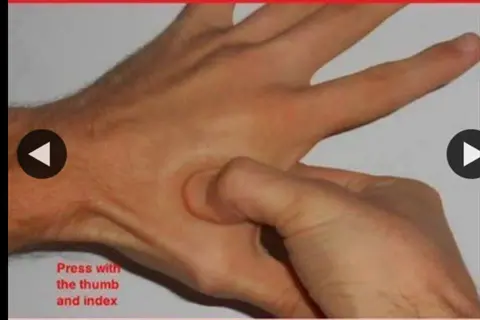
Finger Tips
- All ten fingertips contain reflexology points connected to sinus health
- Pinching fingertips may help relieve congestion and sinus pressure
- Particularly useful during seasonal changes for immune maintenance
- Connect to meridians associated with head and facial structures
- Stimulate by tapping fingertips together or pressing on hard surfaces
- Traditionally used for mental clarity and sensory enhancement
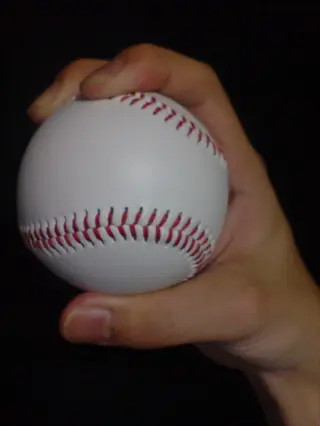
Four Seams
- Located at inner creases of finger joints on both hands
- Gentle massage may support healthy digestion especially in children
- Use light circular motions before meals to stimulate appetite
- Particularly effective for abdominal bloating sensations
- Connect to meridians influencing gastrointestinal tract function
- Avoid excessive pressure which may cause bruising
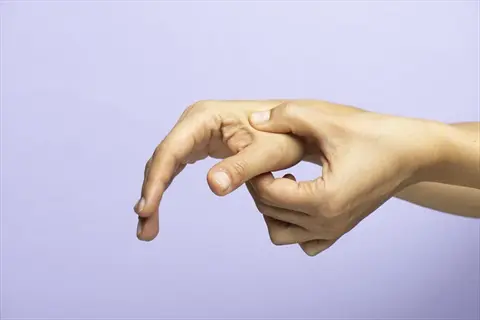
Base of Thumb
- Found at wrist crease directly below thumb on palm side
- Apply pressure to support breathing during respiratory challenges
- Massage this area during seasonal respiratory challenges
- Connects to lung and bronchial reflexology zones
- Effective when combined with pursed-lip breathing techniques
- Traditionally associated with vitality and physical strength
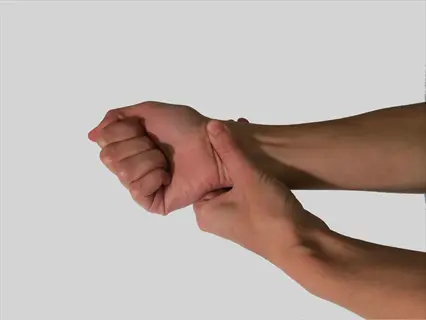
Wrist Point 1
- Located along pinkie-finger line at wrist crease area
- Regular stimulation may help regulate emotional fluctuations
- Apply consistent pressure during moments of emotional intensity
- Associated with heart meridian and emotional processing
- Traditionally used to promote feelings of contentment
- Combine with mindfulness techniques for enhanced benefits
Locating and Applying Pressure
Use anatomical landmarks such as creases and knuckles, or seek them out with tenderness. Palpate gently so that you can feel areas that feel denser than others, which may indicate the presence of energy blocks. I teach clients how to compare each hand for imbalance. Anatomical landmarks provide some uniformity, while tenderness serves as an indicator of individual needs.
Use your thumb pad on large flat areas, plans, for example. Use pressure at 45 45-degree angle to the body. Use the index finger rather than the thumb pad on sensitive points. For those with sensitive nails, acupressure devices can be helpful. Knuckles can be used to reach deep-seated areas more safely.
Pressure is significant. Start light as a feather and produce firm pressure to an amount that is a dull ache and never a bone-shard, great big pain. Students are reminded that discomfort means stop. Effective stimulation feels like deep warmth creeping in under the skin.
Position your body correctly by sitting with your wrists resting on the table. Your spine should be straight to allow energy to flow freely. I've observed that improvements in posture improve one's technique two-fold. Proper alignment can prevent strain when practicing for extended periods.
Anatomical Landmark Method
- Identify points using visible hand structures like creases, knuckles, and webbing
- Example: Locate Hand Valley (LI4) in the fleshy mound between thumb and index finger
- Measure distances using finger widths: Inner Gate (PC6) is three fingers above wrist
- Follow natural hand contours where valleys and bumps indicate reflex zones
- Use consistent reference points like nail beds and joint lines for precision
- Mark points temporarily with skin-safe pen during initial learning phases
Tenderness Detection
- Gently palpate hand areas with moderate pressure using thumb pad
- Notice subtle differences: energy-blocked points feel denser or more sensitive
- Compare symmetrical points on both hands to identify imbalances
- Tenderness often indicates corresponding body system needs attention
- Avoid pressing inflamed or bruised areas that cause sharp pain
- Document tender points to track changes across multiple sessions
Thumb Application
- Use thumb pad for broad areas like palm or lung meridian pathway
- Apply pressure at 45-degree angle using the fleshy part near joint
- Maintain short fingernails to prevent scratching during circular motions
- Rotate in clockwise circles with steady pressure for 5-10 seconds
- Distribute weight through arm to avoid thumb joint strain
- Alternate between circular and stationary pressure techniques
Precision Point Stimulation
- Use index finger for small points like fingertip or wrist zones
- Apply perpendicular pressure with finger pad rather than nail tip
- Combine with thumb support: press point with index while thumb braces hand underside
- For deep points: use knuckle with gentle rocking motion
- Acupressure tools like wooden probes allow targeted pressure without fingernails
- Limit precision work to 2-minute intervals to prevent finger fatigue
Pressure Duration Protocol
- General rule: Maintain pressure for 5-10 seconds per point
- For acute issues: 3 rounds of 10-second pressure with 5-second rests
- Chronic conditions: Longer holds (15-20 seconds) at lighter pressure
- Frequency: Repeat stimulation 2-3 times daily for consistency
- Monitor reactions: Stop if numbness, tingling or discomfort develops
- Post-session: Hydrate with 8oz (237ml) water to support energy flow
Top 3 Benefits and Protocols
Stress relief is the easiest way to start hand reflexology for beginners. Apply pressure to Heart 7 for thirty seconds while sitting down. Repeat three times a day. A warm dull ache will spread throughout your palms like a sign that you have been effective. No sharp pain should develop.
For acute problems like headaches, the LI4 point is indicated with firm but comfortable pressure, held for 15 seconds every 30 minutes. For chronic conditions, lighter pressure for a longer time is needed; try 20-second sessions twice per day. I encourage clients to keep a journal of their responses for appropriate adjustments.
Acknowledge proper somatic cues, such as warmth, which means energy is moving, and burning, which means stop. A dull aching sensation is an indication of effective somatic stimulation. If you are working with nausea at PC6 and notice clearing with gurgling sounds, just stop. These cues can help you calibrate effectively and safely in a manner personalized to you.
Short, frequent sessions should be emphasized for beginners over longer, more extended sessions. I've seen better long-term results with five-minute apps that deliver results than with an hour's attempt. The most important thing is the regularity of the application, not intensity. This is particularly true in the area of stress management. Always be guided by the reply of the body.
Stress and Anxiety Relief
- Primary points: Heart 7 (Shenmen) + full-hand systematic pressure
- Protocol: Apply 30-second pressure per point while seated with eyes closed
- Frequency: Three sessions daily (morning, afternoon, pre-bed), 5 minutes each
- Enhancement: Combine with 4-7-8 breathing (inhale 4s, hold 7s, exhale 8s)
- Physical cue: Stop when feeling warmth spreading through palms
- Acute stress response: Focus only on Heart 7 with quick 10-second presses
Headache and Migraine Reduction
- Key points: Hand Valley (LI4) + Outer Gate (SJ5) + temple pressure
- Protocol: Hold LI4 firmly for 15 seconds, then SJ5 for 15 seconds
- Frequency: Repeat every 30 minutes during headache episodes (max 6 rounds)
- Enhancement: Apply cold compress to temples while stimulating points
- Physical cue: Release when tension shifts from temples to jawline
- Chronic migraine prevention: Daily morning sessions even without pain
Digestive Support
- Target points: Inner Gate (PC6) + Four Seams + clockwise palm massage
- Protocol: Massage PC6 in small circles for 1 minute before meals
- Frequency: Stimulate Four Seams 3x daily with light thumb rotations
- Enhancement: Perform while seated with spine straight for optimal effect
- Physical cue: Continue until hearing stomach gurgling sounds
- Acute nausea: Press PC6 firmly with thumb during nausea waves
Safety and Integration
Comprehend contraindications exquisitely: complete avoidance of reflexology in existence of open hand wounds or infection disease states. Postponement to be observed in such cases when there is an exacerbation of arthritis. The LI4 point in pregnancy completely omitted. These are indicators of absolute prohibition. cases of precautionary nature require medical clearance, e.g., blood coagulative disorders.
Respect limits of pressure: apply strong pressure as to create only a dull ache. If sharp pain, pressure must be released immediately. Watch for reactions of the skin: mild redness is permissible but bruises necessitate cessation of the pressure. Do not apply pressure for more than two minutes under any circumstances except for the purpose of relieving nerve irritation.
When to seek professional advice: Self-care is good for general well-being, but diagnosed conditions need professionals. People with chronic symptoms should find certified reflexologists. Discuss your self-care practice with your physician. I suggest that clients obtain practitioner referrals for persistent symptoms.
Following your sessions, it is essential to hydrate: within 10 minutes drink 8oz of water to promote energy flow and shed toxins. Combine this with some aromatherapy (i.e. lavender) for anxiety. as always stretch your wrists. The benefit of hydration I have seen two fold.
Contraindications
- Avoid completely with open wounds, infections, or burns on hands
- Postpone during active inflammation like arthritis flare-ups
- Require medical clearance for blood clotting disorders or anticoagulant use
- Not recommended immediately after hand surgery or fracture healing
- Pregnancy precaution: Avoid LI4 and other points stimulating uterine activity
- Discontinue if experiencing persistent numbness or tingling sensations
Pressure Limits and Warning Signs
- Safe sensation: Dull ache or warmth indicates effective stimulation
- Warning sign: Sharp pain signals immediate pressure release needed
- Skin reaction limit: Mild redness acceptable, bruising requires discontinuation
- Time threshold: Never exceed 2 continuous minutes per point
- Nerve sensitivity: Tingling beyond 5 minutes post-session needs evaluation
- Progression rule: Start with light pressure, increase gradually over sessions
Professional vs. Self-Care Boundaries
- Self-care scope: Limited to general wellness and mild discomfort relief
- Professional referral needed: Chronic pain, diagnosed conditions, or pregnancy
- Therapist qualifications: Verify certification from accredited reflexology programs
- Session frequency: Maximum 3 self-care sessions daily; professionals determine clinical frequency
- Integration tip: Share your self-care routine with healthcare providers
- Documentation: Record reactions to share with practitioners during consultations
Holistic Pairing Practices
- Anxiety combo: Pair with lavender aromatherapy during evening sessions
- Respiratory support: Combine with eucalyptus steam inhalation
- Digestive aid: Perform before ginger tea consumption
- Energy alignment: Follow with 5-minute meditation focusing on palm warmth
- Physical integration: Stretch wrists and fingers after sessions
- Device use: Limit to 15 minutes with acupressure rings between sessions
Mistake Prevention Protocol
- Hydration rule: Drink 8oz (237ml) water within 10 minutes post-session
- Cleanliness: Wash hands before/after; sanitize tools weekly
- Positioning: Always work with supported wrists on flat surface
- Timing: Avoid within 30 minutes of meals or intense exercise
- Sensitivity test: Check point tenderness before applying pressure
- Progress tracking: Journal reactions for pattern identification
5 Common Myths
Hand reflexology provides instant relief for chronic health problems such as arthritis or hypertension after the first treatment session.
While temporarily relieving the symptoms of chronic problems, reflexology does not cure or effect instant recovery from diagnosed diseases. All chronic conditions require continual professional treatment, and any type of reflexology should tend to aid, not diminish, medical treatment. Health benefits are felt more through cumulative results derived from regular practice such as hydration helps general health but cannot heal specific diseases in and of itself. Before using reflexology in the treatment of chronic diseases, it is advised that consultation with health care be obtained.
Applying intense pain during hand reflexology means it's working effectively and breaking down energy blockages.
Pain is never an indicator of effective reflexology; proper technique involves firm but comfortable pressure that creates a dull ache or warmth. Sharp pain signals potential nerve irritation or tissue damage, requiring immediate pressure release. The principle of energy flow improvement centers on gentle stimulation, not forceful intervention. Persistent discomfort may indicate improper point location or underlying health issues needing professional evaluation. Always prioritize comfort and stop immediately if pain occurs.
Reflexology points on the hands can heal diseases by stimulating the function of organs through channels of energy.
Hand reflexology is concentrated on promoting general health and the reduction of stress, rather than the healing of diseases or the direct action of the organs. While it may serve to promote relaxation and subjective wellness, there is no scientific evidence to show that these areas on the reflex points are capable of treating diseases. The study of reflexology must be looked upon in the light of holistic therapies which are directed toward energy balance rather than physiological measures. It may be an adjunct to medical care, with an attendant professional, but never a substitute for scientifically -based remedies for named diseases.
Anyone can perform professional-level hand reflexology after watching online tutorials without formal training or certification.
While basic self-care techniques are accessible, professional reflexology requires comprehensive training in anatomy, pressure application, and contraindications. Accredited programs involve hundreds of supervised practice hours to ensure safety and efficacy. Untrained individuals risk improper technique leading to bruising or nerve irritation. For addressing specific health concerns, always seek certified practitioners. Self-care should focus only on general wellness, not therapeutic interventions requiring clinical expertise.
Reflexology works for everyone, no matter what their health status, age, or body chemistry may be.
But people respond differently for many reasons, such as: amount of stress, degree of hydration, health history, and nerve sensitivity. The old prefer gentle pressure because of thin skins, while chronic neuropathy patients may be unable to sense the pressure at all. Frequency is of more importance than intensity; it is better to have short treatments often than long treatments rarely in order to obtain cumulative benefits. It is always necessary to conform the various techniques to one's individual tolerance, and to vary the techniques according to daily wellbeing.
Conclusion
Hand reflexology provides an excellent self-care option to fit any busy schedule. This ancient healthcare practice is now accessible to everyone. I have worked with clients using simple techniques to improve their daily health routine significantly. It can be a wonderful complement to today's medical procedures if used wisely.
Make daily practice your goal; steady five-minute sessions reap great gains over time. Start with morning and evening sessions, concentrating on the main points. I advise beginners, if they so wish, to record their progress each week. Little but constant, steady work pays better than an occasional heavy assault.
To learn more, read books like "The Complete Guide to Hand Reflexology" by Barbara Kunz. Local wellness centers also offer classes for beginners. Be sure to check their certifications. I still highly suggest learning the basics first, then taking workshops.
Now, natural healing is literally at your fingertips. Use these techniques with confidence and patience. I have seen significant improvements in wellness among those who persist. Your hands are powerful tools for living in balance.
External Sources
Frequently Asked Questions
What are forbidden pressure points in hand reflexology?
Certain points require caution: avoid LI4 during pregnancy due to uterine stimulation potential, inflamed areas, or post-surgery sites. Never apply intense pressure on thin-skinned areas over bones. Always consult professionals for diagnosed conditions.
What does pain during hand reflexology indicate?
Pain signals improper technique: sharp sensations mean immediate pressure release is needed. Effective stimulation creates only mild warmth or dull ache. Persistent discomfort suggests incorrect point location or underlying issues requiring professional evaluation.
Where is the primary anxiety relief point?
Heart 7 (Shenmen) on the wrist crease between ring and pinkie fingers is key. Apply gentle circular pressure for 30 seconds while practicing deep breathing to calm nervous system responses.
Can hand reflexology provide real benefits?
Research suggests benefits for stress reduction and symptom management. Regular practice may improve relaxation and mild discomfort relief when combined with conventional care. It supports wellness but doesn't replace medical treatments.
- Reduces anxiety through nervous system modulation
- Eases tension headaches via specific pressure points
- Improves sleep quality with pre-bed sessions
How often should I practice hand reflexology?
For general wellness: brief daily sessions of 5-10 minutes per hand. Target acute issues like headaches with focused 15-second holds every 30 minutes. Chronic concerns benefit from 2-3 consistent daily applications.
What are risks of improper hand reflexology?
Potential issues include bruising from excessive pressure, nerve irritation causing tingling, or temporary discomfort. Avoid sessions with hand injuries, infections, or blood disorders. Discontinue if numbness persists beyond 5 minutes.
Where are the best hand massage points?
Key zones include the fleshy LI4 between thumb/index finger for headaches, PC6 three finger-widths above the wrist for nausea, and fingertips for sinus relief. Palm center points support overall relaxation.
- LI4: Headache and tension relief
- PC6: Nausea reduction
- Fingertips: Sinus pressure relief
What is emotional release in reflexology?
Some experience emotional shifts like sudden calm or tearfulness during sessions. This reflects stress reduction and nervous system rebalancing. It's a normal response to pressure point stimulation releasing stored tension.
Can I perform hand reflexology on myself?
Yes, self-care is accessible: use thumb for broad areas and index finger for precision points. Follow safety guidelines like proper pressure limits and session duration. Seek professionals for health condition management.
- Clean hands before starting
- Support wrists on flat surface
- Limit sessions to 5-10 minutes
Do medical professionals endorse reflexology?
Many integrate it as complementary care for stress and symptom management alongside conventional treatments. While not a standalone cure, studies note benefits for quality of life when practiced safely.

